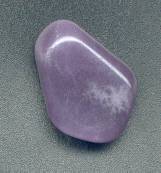Compared to the widespread, well-crystallized, transparent representatives of its kind, coarse fluorite is a little noticed mineral. Its relatively inconspicuous and "atypical" appearance, often leads to confusion with other minerals.
Many of these derby fluorites are very hydrous and are therefore called Hydro-Fluorite. (Hydro-) Fluorite (CaF2 x H2O) has a hardness of 4 on the Mohs scale and a density of 3.1 - 3.3. The most common variety commes in purple color.
Hydrofluorite as imitation for »Lavender Jade«

Hydrofluorite offered as »Lavender Jade«
Foto: EPI
Compact, hydrous, purple fluorite is often mistakenly offered as »lavender jade«.
Unlike true purple» lavender jade«, which consists of either jadeite or the jadeite-bearing purple Meta-Granitoide rock from Turkey, the purple variety of Hydro-Fluorite has a fibrous structure.
In addition, it has a much lower Mohs hardness (H: 4) compared to jadeite (H: 6). Fluorite can be scratched easily with a stainless steel knife. Jadeite, on the other hand, cannot be scratched with such a knife.
Hydrofluorit as (Chevron-) Amethyst
Hydrofluorite may occasionally show white bands. Purple specimens with such white bands are often confused with amethyst, especially with its coarse variety "chevron amethyst".
A distinction is possible on the basis of the lower density of quartz (only 2.65 - 2.68) and the greater hardness of 7, which allows to scratch glass. With a fluorite this will not be possible.
With rough pieces, the plain fracture of fluorite can also be used for separation, since quartz always breaks conchoidally.
Hydrofluorite as Chrysoprase Imitation
Green, translucent (hydro-) fluorite can resemble varieties of chalcedony, called »chrysoprase«, chrome chalcedony and »prasem«. All three can be distinguished by their higher Mohs hardness (H: 7) from fluorite (H: 4).
Some time ago a green rock was submitted to the EPI laboratory with the name given as "fluorine chrysoprase". According to mineralogical nomenclature rules, "fluorine chrysoprase" should be a variety of chalcedony containing the elements nickel (the coloring element of chrysoprase) and fluorine.
The microscopic examination revealed, that the specimens did not show the expected fibrous structure of a chalcedony, but a rather granular composition. Well recognizable cleavage cracks indicated a very good cleavability. Also the high density of 2.9 - 3.1 did not match with chrysoprase, whose density is 2.6 - 2.7. On a polished surface a refractive index of 1.45 could be determined, a value which does not point out chalcedony, but rather fluorite.
To determine the exact mineral composition and elemental content, a mineralogical thin section was made and X-ray fluorescence analysis (XRF) were performed. The thin section analysis clearly showed that in addition to fluorite and the remains of decomposed feldspars, only coarsely crystallized quartz - but no chalcedony - is present. The trace element analysis (XRF) showed no measurable content of nickel.
After these analysis results we knew, that we have analyzed an interesting example of a (Hydro-) Fluorite.
Conclusion
Fluorite is relatively easy to distinguish from "jade", quartz or chalcedony when in doubt due to its low hardness. A simple scratch test with a knife leaves a deep notch on a fluorite. Representatives of the quartz family, on the other hand, remain intact in this test.
Autor: Dipl.-Min. B. Bruder
© INSTITUT FÜR EDELSTEIN PRÜFUNG (EPI), 2021
read more on this topic:





